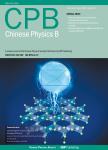Role of hydrogen bonding in solubility of poly(N-isopropylacrylamide) brushes in sodium halide solutions
Role of hydrogen bonding in solubility of poly(N-isopropylacrylamide) brushes in sodium halide solutions作者机构:Xinjiang Laboratory of Phase Transitions and Microstructures of Condensed Matter Physics Yi Li Normal University National Laboratory of Solid State Microstructures and Department of Physics Nanjing University Xinjiang Astronomical Observatory Chinese Academy of Sciences
出 版 物:《Chinese Physics B》 (中国物理B(英文版))
年 卷 期:2016年第25卷第7期
页 面:277-285页
核心收录:
学科分类:081704[工学-应用化学] 07[理学] 070304[理学-物理化学(含∶化学物理)] 08[工学] 0817[工学-化学工程与技术] 070305[理学-高分子化学与物理] 080501[工学-材料物理与化学] 0805[工学-材料科学与工程(可授工学、理学学位)] 0703[理学-化学]
基 金:Project supported by the National Natural Science Foundation of China(Grant Nos.21264016,11464047,and 21364016) the Joint Funds of Xinjiang Natural Science Foundation,China(Grant No.2015211C298)
主 题:molecular theory PNIPAM brushes anion effect hydrogen bonds
摘 要:By employing molecular theory, we systematically investigate the shift of solubility of poly(N-isopropylacrylamide)(PNIPAM) brushes in sodium halide solutions. After considering PNIPAM–water hydrogen bonds, water–anion hydrogen bonds, and PNIPAM–anion bonds and their explicit coupling to the PNIPAM conformations, we find that increasing temperature lowers the solubility of PNIPAM, and results in a collapse of the layer at high enough temperatures. The combination of the three types of bonds would yield a decrease in the solubility of PNIPAM following the Hofmeister series: Na Cl>Na Br>Na I. PNIPAM–water hydrogen bonds are affected by water–anion hydrogen bonds and PNIPAM–anion bonds. The coupling of polymer conformations and the competition among the three types of bonds are essential for describing correctly a decrease in the solubility of PNIPAM brushes, which is determined by the free energy associated with the formation of the three types of bonds. Our results agree well with the experimental observations, and would be very important for understanding the shift of the lower critical solution temperature of PNIPAM brushes following the Hofmeister series.



